Incorporation of Steel Fibers to Enhance Performance of Sustainable Concrete Made with Waste Brick Aggregates: Experimental and Regression-Based Approaches
Abstract
:1. Introduction
2. Experimental Program
2.1. Test Matrix
2.2. Details and Preparation of Test Specimens
2.3. Material Properties
2.4. Test Setup and Instrumentation
3. Experimental Results
3.1. Ultimate Failure Modes
3.2. Splitting Tensile and Flexural Strengths
3.3. Peak Compressive Strength
3.4. Compressive Stress–Strain Curves
4. Analytical Modeling
4.1. Peak Compressive Strength
4.2. Elastic Modulus
4.3. Rate of Post-Peak Modulus
4.4. Strain at Peak Compressive Strength
4.5. Predicted Compressive Stress–Strain Curves of RBAC
5. Conclusions
- The control specimens in all the groups exhibited typical crushing failure of cylindrical specimens by forming failure cones, splitting cracks along their heights, and exhibiting extensive crushing. The specimens strengthened with steel fibers indicated a delayed failure compared to that of the control specimens. In addition, the magnitude of splitting and crushing was reduced.
- The control flexural specimens in all the groups did not show any ductility and demonstrated an abrupt drop in the flexural strength after reaching the peak load. The addition of 1% volume fraction of steel fibers did not impart any noticeable ductility. However, a substantial improvement in the ductility was observed for 2% and 3% volume fractions of steel fibers. Further, the rate of the post-peak flexural strength degradation decreased as the volume fraction of steel fibers increased. The enhancement in the energy dissipation was more pronounced than the increase in the flexural strength. An 8765.69% increase in the energy dissipation by the flexural specimens was witnessed in group 3 specimens, while this increase in group 2 and group 4 specimens was 5823.61% and 6748.36%, respectively.
- Like the flexural specimens, the splitting tensile specimens also provided an increased ductility as the volume fraction of steel fibers increased. Generally, the maximum ductility was observed, corresponding to 3% volume fraction of steel fibers.
- The addition of steel fibers improved the peak compressive strength in all the groups. However, this increase was maximum in the case of group 2 specimens for all the volume fractions of steel fibers. Nonetheless, steel fibers could not enhance the peak compressive strength of RBAC to the value that corresponded to natural aggregates concrete.
- Separate equations were proposed to predict the peak compressive strength, strain at the peak compressive strength, elastic modulus, and post-peak modulus of RBAC. The proposed regression equations were utilized in combination with the existing compressive stress–strain model. In general, a close agreement was achieved between the experimental and predicted compressive stress–strain curves of RBAC.
Author Contributions
Funding
Data Availability Statement
Conflicts of Interest
References
- Li, H.; Dong, L.; Jiang, Z.; Yang, X.; Yang, Z. Study on Utilization of Red Brick Waste Powder in the Production of Cement-Based Red Decorative Plaster for Walls. J. Clean. Prod. 2016, 133, 1017–1026. [Google Scholar] [CrossRef]
- Meng, Q.; Qin, Q.; Yang, H.; Zhou, H.; Wu, K.; Wang, L. Fractal Characteristics of the Pore Structure of Coral Powder–Cement Slurry under Different Fractal Models. Fractal Fract. 2022, 6, 145. [Google Scholar] [CrossRef]
- Wimala, M. Environmental Impact of Waste Concrete Treatment in Precast Concrete Production. In Proceedings of the Annual Conference Japan Concrete Institute, Osaka, Japan, 12–14 July 2011; pp. 1902–1906. [Google Scholar]
- Joyklad, P.; Saingam, P.; Ali, N.; Ejaz, A.; Hussain, Q.; Khan, K.; Chaiyasarn, K. Low-Cost Fiber Chopped Strand Mat Composites for Compressive Stress and Strain Enhancement of Concrete Made with Brick Waste Aggregates. Polymers 2022, 14, 4714. [Google Scholar] [CrossRef]
- He, Z.; Shen, A.; Wu, H.; Wang, W.; Wang, L.; Yao, C.; Wu, J. Research Progress on Recycled Clay Brick Waste as an Alternative to Cement for Sustainable Construction Materials. Constr. Build. Mater. 2021, 274, 122113. [Google Scholar] [CrossRef]
- Meng, T.; Zhang, J.; Wei, H.; Shen, J. Effect of Nano-Strengthening on the Properties and Microstructure of Recycled Concrete. Nanotechnol. Rev. 2020, 9, 79–92. [Google Scholar] [CrossRef]
- Zheng, C.; Lou, C.; Du, G.; Li, X.; Liu, Z.; Li, L. Mechanical Properties of Recycled Concrete with Demolished Waste Concrete Aggregate and Clay Brick Aggregate. Results Phys. 2018, 9, 1317–1322. [Google Scholar] [CrossRef]
- Vilas, N.; Guilbert, B. Construction and Demolition Waste Management: Current Practices in Asia. In Proceedings of the International Conference on Sustainable Solid Waste Management, Chennai, India, 5–7 September 2007; pp. 97–104. [Google Scholar]
- Tabsh, S.W.; Abdelfatah, A.S. Influence of Recycled Concrete Aggregates on Strength Properties of Concrete. Constr. Build. Mater. 2009, 23, 1163–1167. [Google Scholar] [CrossRef]
- Kwan, W.H.; Ramli, M.; Kam, K.J.; Sulieman, M.Z. Influence of the Amount of Recycled Coarse Aggregate in Concrete Design and Durability Properties. Constr. Build. Mater. 2012, 26, 565–573. [Google Scholar] [CrossRef]
- Padmini, A.K.; Ramamurthy, K.; Mathews, M.S. Influence of Parent Concrete on the Properties of Recycled Aggregate Concrete. Constr. Build. Mater. 2009, 23, 829–836. [Google Scholar] [CrossRef]
- Saingam, P.; Ejaz, A.; Ali, N.; Nawaz, A.; Hussain, Q.; Joyklad, P. Prediction of Stress-Strain Curves for HFRP Composite Confined Brick Aggregate Concrete under Axial Load. Polymer 2023, 15, 844. [Google Scholar] [CrossRef]
- Vrijders, J.; Desmyter, J. Een Hoogwaardig Gebruik van Puingranulaten Stimuleren; OVAM: Mechelen, Belgium, 2008. [Google Scholar]
- Debieb, F.; Kenai, S. The Use of Coarse and Fine Crushed Bricks as Aggregate in Concrete. Constr. Build. Mater. 2008, 22, 886–893. [Google Scholar] [CrossRef]
- Bai, G.; Zhu, C.; Liu, C.; Liu, B. An Evaluation of the Recycled Aggregate Characteristics and the Recycled Aggregate Concrete Mechanical Properties. Constr. Build. Mater. 2020, 240, 117978. [Google Scholar] [CrossRef]
- Medina, C.; Zhu, W.; Howind, T.; Sánchez De Rojas, M.I.; Frías, M. Influence of Mixed Recycled Aggregate on the Physical—Mechanical Properties of Recycled Concrete. J. Clean. Prod. 2014, 68, 216–225. [Google Scholar] [CrossRef]
- Nováková, I.; Mikulica, K. Properties of Concrete with Partial Replacement of Natural Aggregate by Recycled Concrete Aggregates from Precast Production. Procedia Eng. 2016, 151, 360–367. [Google Scholar] [CrossRef]
- Jiang, T.; Wang, X.M.; Zhang, W.P.; Chen, G.M.; Lin, Z.H. Behavior of FRP-Confined Recycled Brick Aggregate Concrete under Monotonic Compression. J. Compos. Constr. 2020, 24, 04020067. [Google Scholar] [CrossRef]
- Nixon, P.J. Recycled Concrete as an Aggregate for Concrete—A Review. Matériaux Constr. 1978, 11, 371–378. [Google Scholar] [CrossRef]
- Thomas, C.; Setién, J.; Polanco, J.A.; Alaejos, P.; Sánchez De Juan, M. Durability of Recycled Aggregate Concrete. Constr. Build. Mater. 2013, 40, 1054–1065. [Google Scholar] [CrossRef]
- Rodsin, K. Confinement Effects of Glass FRP on Circular Concrete Columns Made with Crushed Fired Clay Bricks as Coarse Aggregates. Case Stud. Constr. Mater. 2021, 15, e00609. [Google Scholar] [CrossRef]
- Harajli, M.H. Axial Stress–Strain Relationship for FRP Confined Circular and Rectangular Concrete Columns. Cem. Concr. Compos. 2006, 28, 938–948. [Google Scholar] [CrossRef]
- Harajli, M.H. Seismic Behavior of RC Columns with Bond-Critical Regions: Criteria for Bond Strengthening Using External FRP Jackets. J. Compos. Constr. 2008, 12, 69–79. [Google Scholar] [CrossRef]
- Garcia, R.; Helal, Y.; Pilakoutas, K.; Guadagnini, M. Bond Behaviour of Substandard Splices in RC Beams Externally Confined with CFRP. Constr. Build. Mater. 2014, 50, 340–351. [Google Scholar] [CrossRef]
- Bournas, D.A.; Triantafillou, T.C. Bond Strength of Lap-Spliced Bars in Concrete Confined with Composite Jackets. J. Compos. Constr. 2011, 15, 156–167. [Google Scholar] [CrossRef]
- Saleem, S.; Hussain, Q.; Pimanmas, A. Compressive Behavior of PET FRP–Confined Circular, Square, and Rectangular Concrete Columns. J. Compos. Constr. 2016, 21, 04016097. [Google Scholar] [CrossRef]
- Suparp, S.; Ejaz, A.; Khan, K.; Hussain, Q.; Joyklad, P.; Saingam, P. Load-Bearing Performance of Non-Prismatic RC Beams Wrapped with Carbon FRP Composites. Sensors 2023, 23, 5409. [Google Scholar] [CrossRef] [PubMed]
- Gao, C.; Huang, L.; Yan, L.; Kasal, B.; Li, W. Behavior of Glass and Carbon FRP Tube Encased Recycled Aggregate Concrete with Recycled Clay Brick Aggregate. Compos. Struct. 2016, 155, 245–254. [Google Scholar] [CrossRef]
- Tang, Z.; Li, W.; Tam, V.W.Y.; Yan, L. Mechanical Behaviors of CFRP-Confined Sustainable Geopolymeric Recycled Aggregate Concrete under Both Static and Cyclic Compressions. Compos. Struct. 2020, 252, 112750. [Google Scholar] [CrossRef]
- Han, Q.; Yuan, W.Y.; Ozbakkaloglu, T.; Bai, Y.L.; Du, X.L. Compressive Behavior for Recycled Aggregate Concrete Confined with Recycled Polyethylene Naphthalate/Terephthalate Composites. Constr. Build. Mater. 2020, 261, 120498. [Google Scholar] [CrossRef]
- Chaiyasarn, K.; Hussain, Q.; Joyklad, P.; Rodsin, K. New Hybrid Basalt/E-Glass FRP Jacketing for Enhanced Confinement of Recycled Aggregate Concrete with Clay Brick Aggregate. Case Stud. Constr. Mater. 2021, 14, e00507. [Google Scholar] [CrossRef]
- Zhou, Y.; Li, W.; Peng, Y.; Tang, S.; Wang, L.; Shi, Y.; Li, Y.; Wang, Y.; Geng, Z.; Wu, K. Hydration and Fractal Analysis on Low-Heat Portland Cement Pastes Using Thermodynamics-Based Methods. Fractal Fract. 2023, 7, 606. [Google Scholar] [CrossRef]
- Peng, Y.; Tang, S.; Huang, J.; Tang, C.; Wang, L.; Liu, Y. Fractal Analysis on Pore Structure and Modeling of Hydration of Magnesium Phosphate Cement Paste. Fractal Fract. 2022, 6, 337. [Google Scholar] [CrossRef]
- Yooprasertchai, E.; Ejaz, A.; Saingam, P.; Ng, A.W.M.; Joyklad, P. Development of Stress-Strain Models for Concrete Columns Externally Strengthened with Steel Clamps. Constr. Build. Mater. 2023, 377, 131155. [Google Scholar] [CrossRef]
- Ejaz, A.; Ruangrassamee, A.; Kruavit, P.; Udomworarat, P.; Wijeyewickrema, A.C. Strengthening of Substandard Lap Splices Using Hollow Steel Section (HSS) Collars. Structures 2022, 46, 128–145. [Google Scholar] [CrossRef]
- Harajli, M.H. Effect of Confinement Using Steel, FRC, or FRP on the Bond Stress-Slip Response of Steel Bars under Cyclic Loading. Mater. Struct. 2006, 39, 621–634. [Google Scholar] [CrossRef]
- Song, P.S.; Hwang, S. Mechanical Properties of High-Strength Steel Fiber-Reinforced Concrete. Constr. Build. Mater. 2004, 18, 669–673. [Google Scholar] [CrossRef]
- Olivito, R.S.; Zuccarello, F.A. An Experimental Study on the Tensile Strength of Steel Fiber Reinforced Concrete. Compos. B Eng. 2010, 41, 246–255. [Google Scholar] [CrossRef]
- Kachouh, N.; El-Hassan, H.; El-Maaddawy, T. Effect of Steel Fibers on the Performance of Concrete Made with Recycled Concrete Aggregates and Dune Sand. Constr. Build. Mater. 2019, 213, 348–359. [Google Scholar] [CrossRef]
- Kaplan, G.; Bayraktar, O.Y.; Gholampour, A.; Gencel, O.; Koksal, F.; Ozbakkaloglu, T. Mechanical and Durability Properties of Steel Fiber-Reinforced Concrete Containing Coarse Recycled Concrete Aggregate. Struct. Concr. 2021, 22, 2791–2812. [Google Scholar] [CrossRef]
- ASTM C39/C39M-21; Standard Test Method for Compressive Strength of Cylindrical Concrete Specimens. ASTM: West Conshohocken, PA, USA, 2021.
- ASTM C1314-21; Standard Test Method for Compressive Strength of Masonry Prisms. ASTM: West Conshohocken, PA, USA, 2021.
- ASTM C140/C140M-22a; Standard Test Methods for Sampling and Testing Concrete Masonry Units and Related Units. ASTM: West Conshohocken, PA, USA, 2022.
- Kou, S.C.; Poon, C.S.; Chan, D. Influence of Fly Ash as Cement Replacement on the Properties of Recycled Aggregate Concrete. J. Mater. Civil. Eng. 2007, 19, 709–717. [Google Scholar] [CrossRef]
- Jin, C.; Wang, X.; Akinkurolere, O.O.; Jiang, C.R. Experimental Research on the Conversion Relationships between the Mechanical Performance Indexes of Recycled Concrete. Chin. Concr. J. 2008, 11. [Google Scholar]
- Li, J.; Xiao, J.; Jian, H. Influence of Recycled Coarse Aggregate Replacement Percentages on Compressive Strength of Concrete—KU Leuven. Jianzhu Cailiao Xuebao/J. Build. Mater. 2006, 9, 297–301. [Google Scholar]
- Richart, F.E.; Brandtzæg, A.; Brown, R.L. A Study of the Failure of Concrete under Combined Compressive Stresses; Bulletin No. 185 Engineering Experiment Station; University of Illinois: Champaign, IL, USA, 1928. [Google Scholar]
- Al-Salloum, Y.A. Compressive Strength Models of FRP-Confined Concrete. In Proceedings of the 1st Asia-Pacific Conference on FRP in Structures, APFIS 2007, Hong Kong, China, 12–14 December 2007; Volume 1, pp. 175–180. [Google Scholar]
- Eid, R.; Paultre, P. Compressive Behavior of FRP-Confined Reinforced Concrete Columns. Eng. Struct. 2017, 132, 518–530. [Google Scholar] [CrossRef]
- Popovics, S. A Numerical Approach to the Complete Stress-Strain Curve of Concrete. Cem. Concr. Res. 1973, 3, 583–599. [Google Scholar] [CrossRef]
- Mander, J.B.; Priestley, M.J.N.; Park, R. Theoretical Stress Strain Model for Confined Concrete. J. Struct. Eng. 1988, 114, 1804–1826. [Google Scholar] [CrossRef]

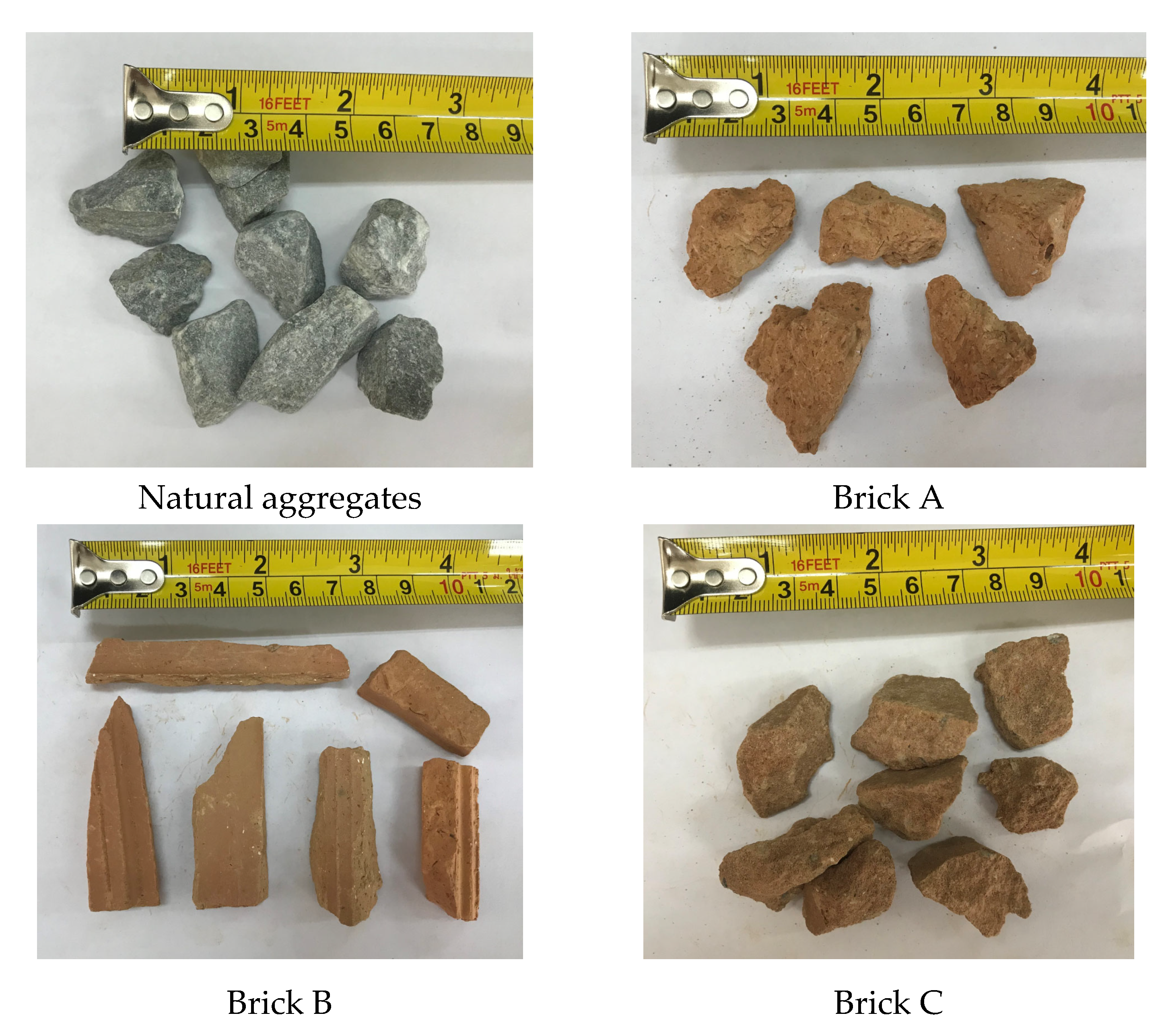

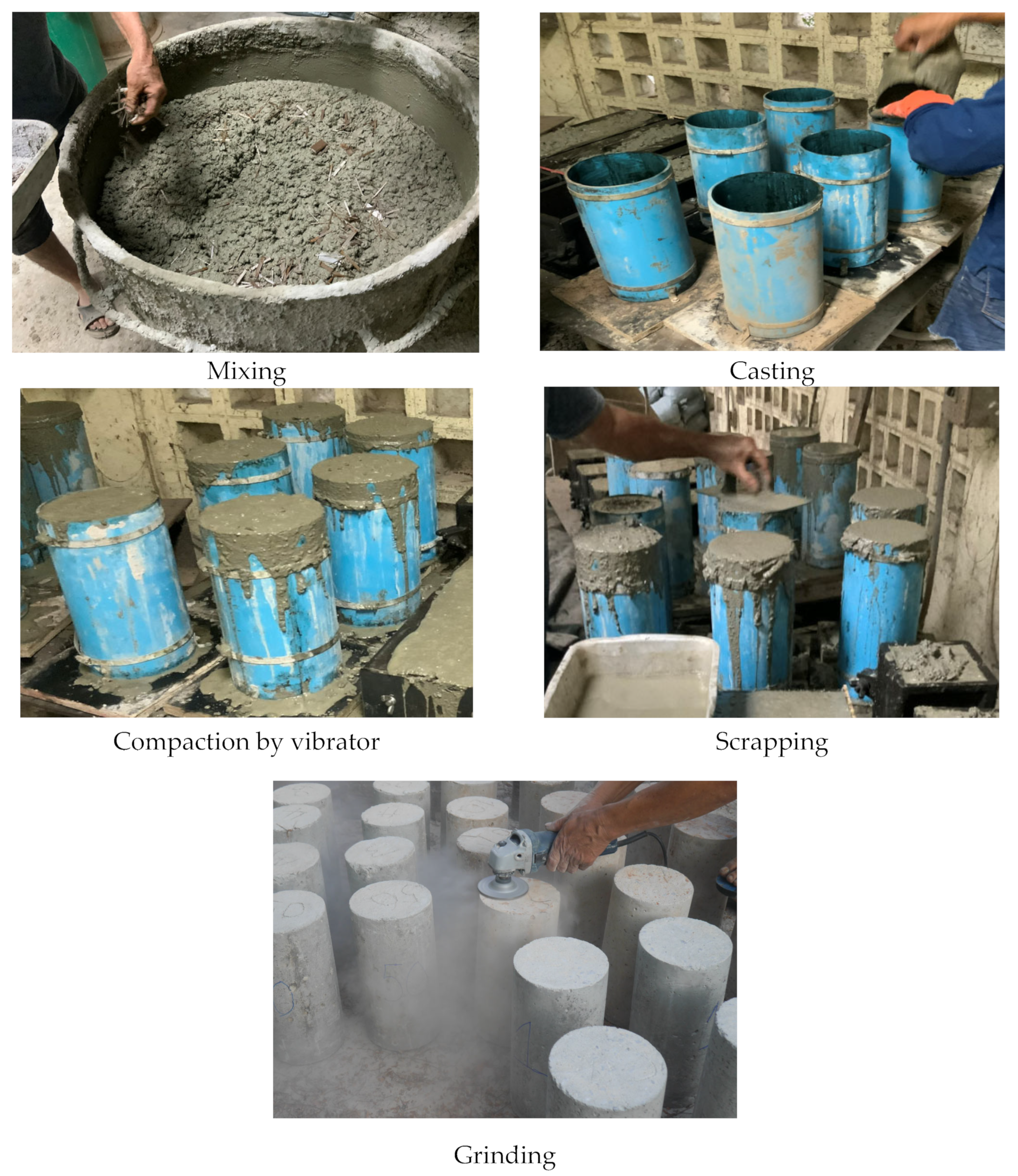
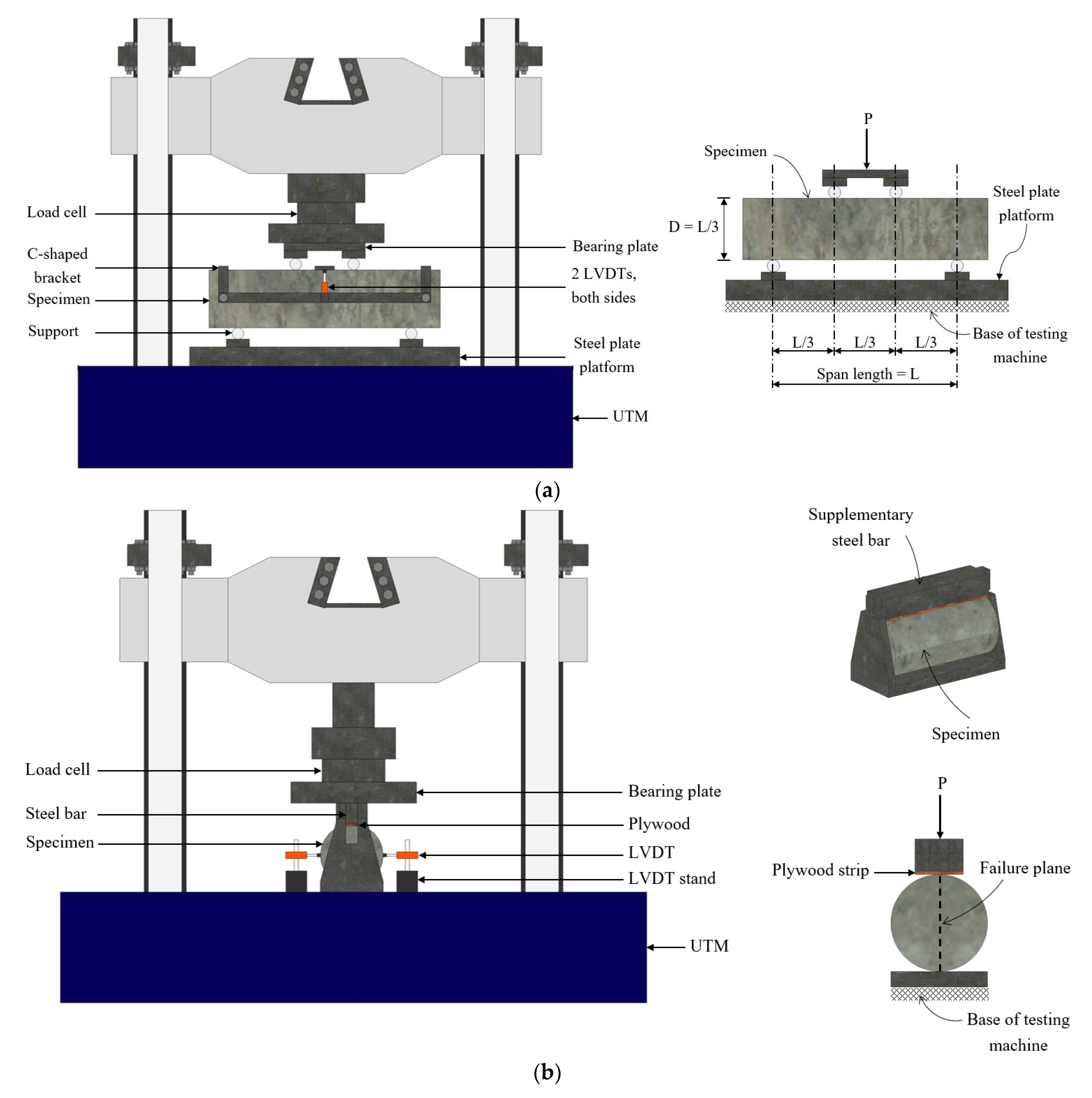
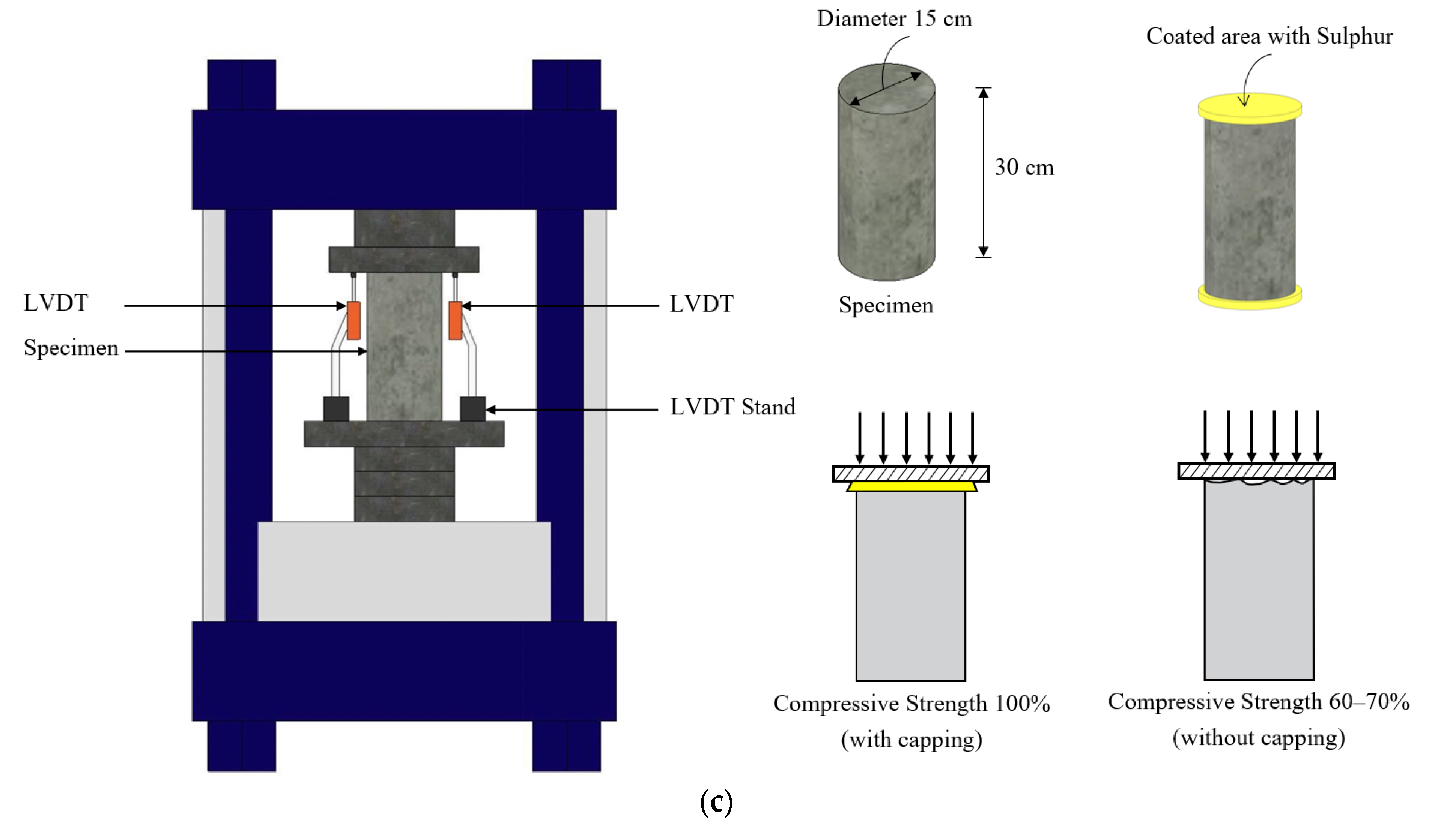


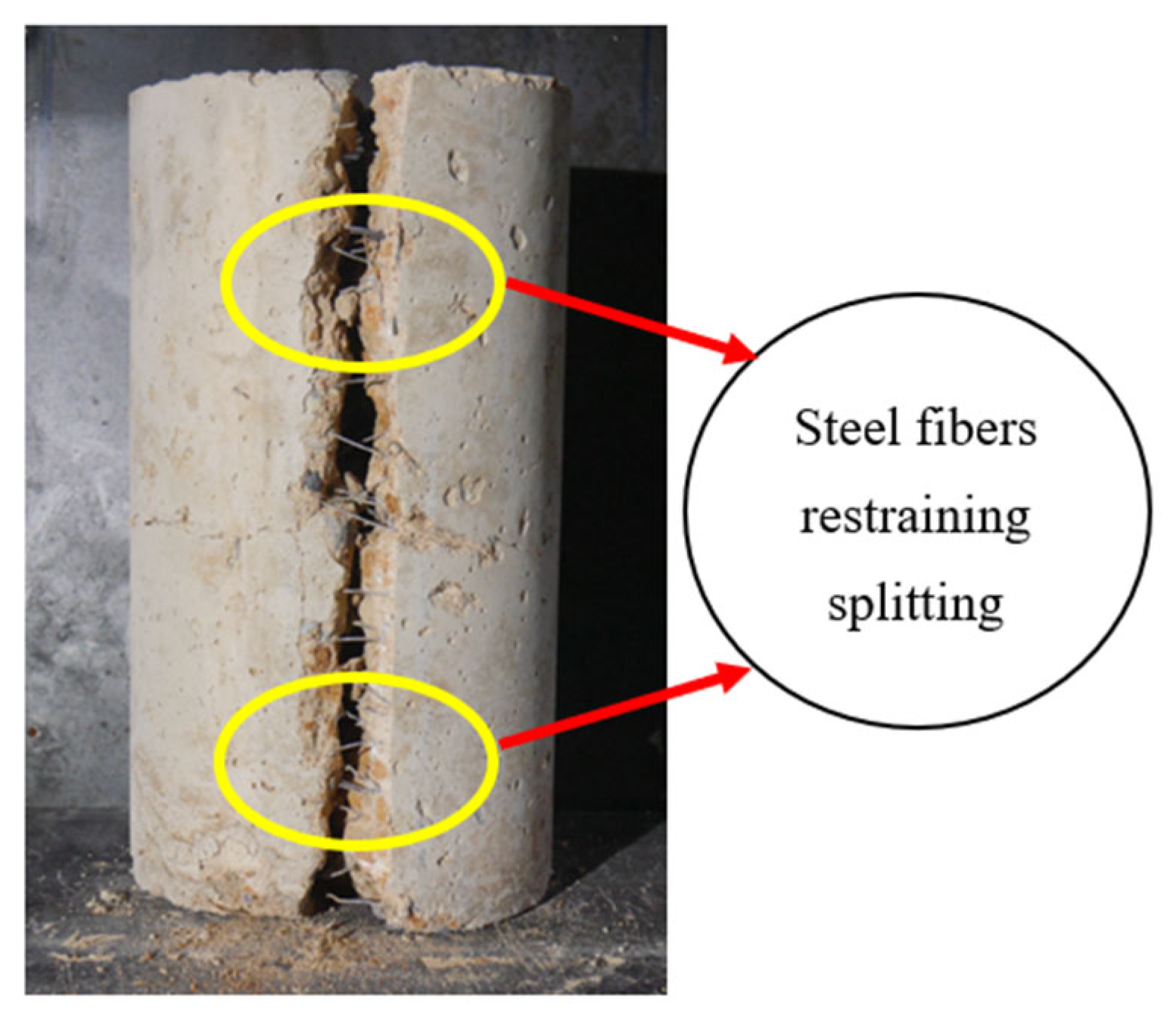


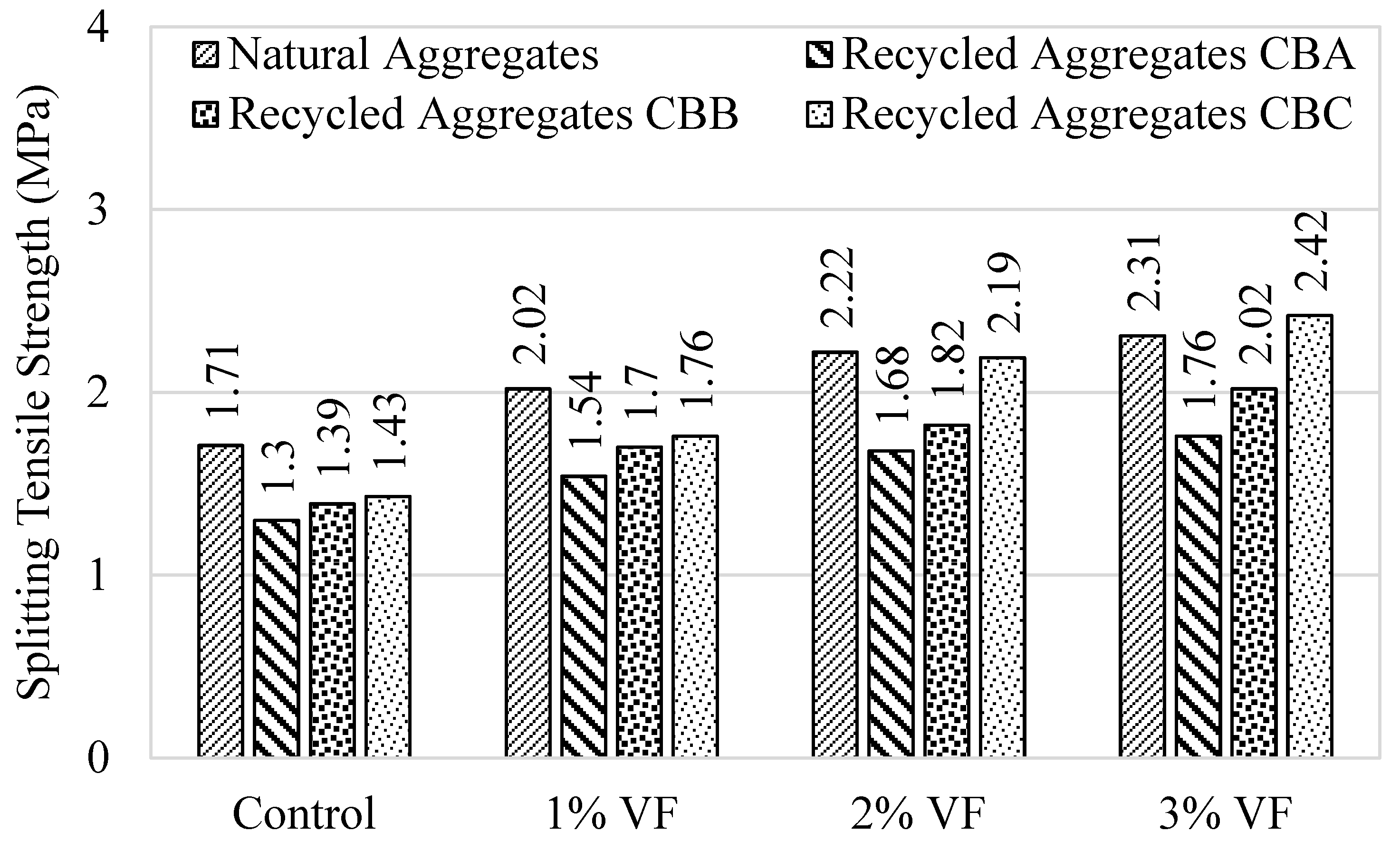





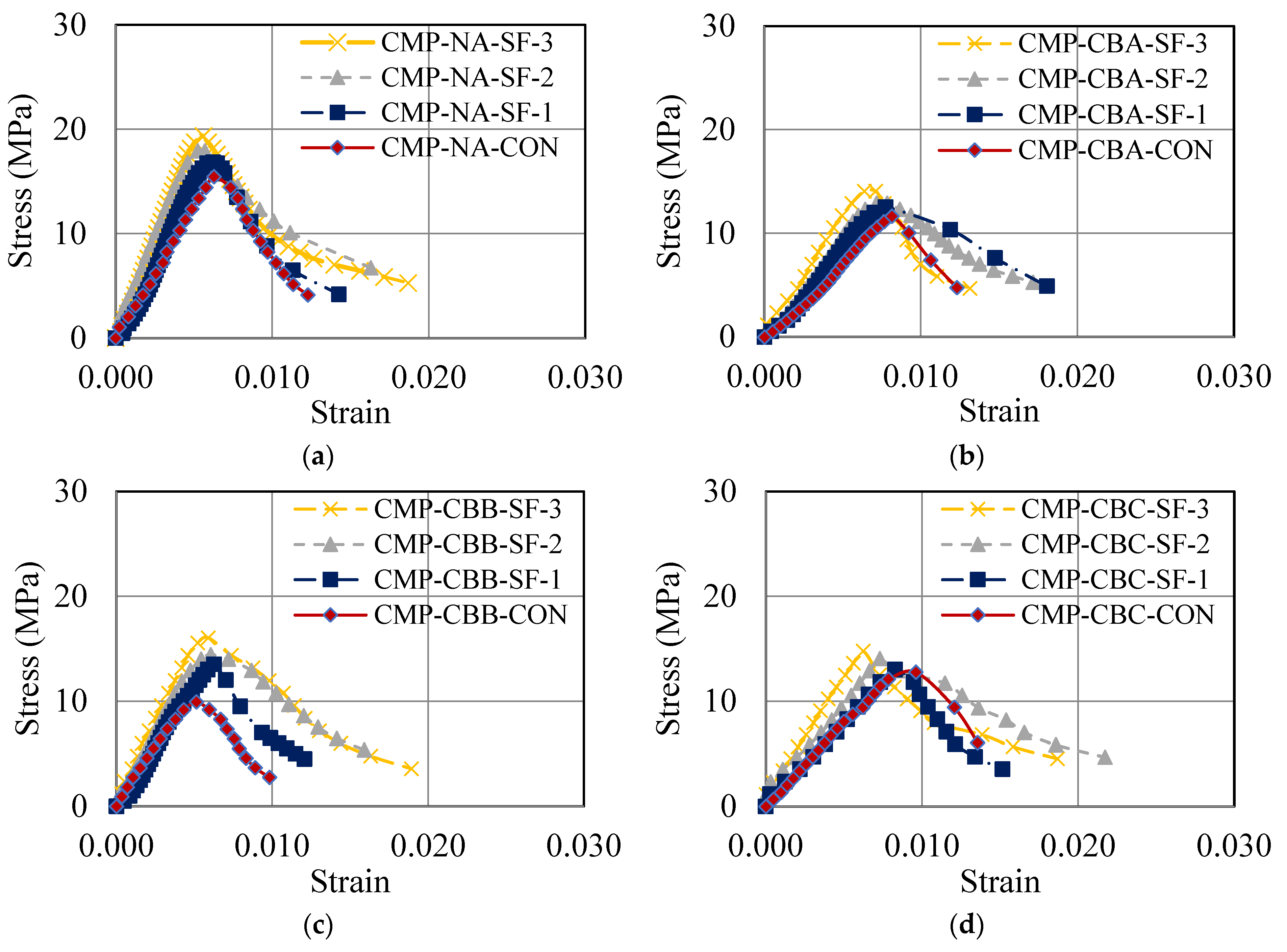
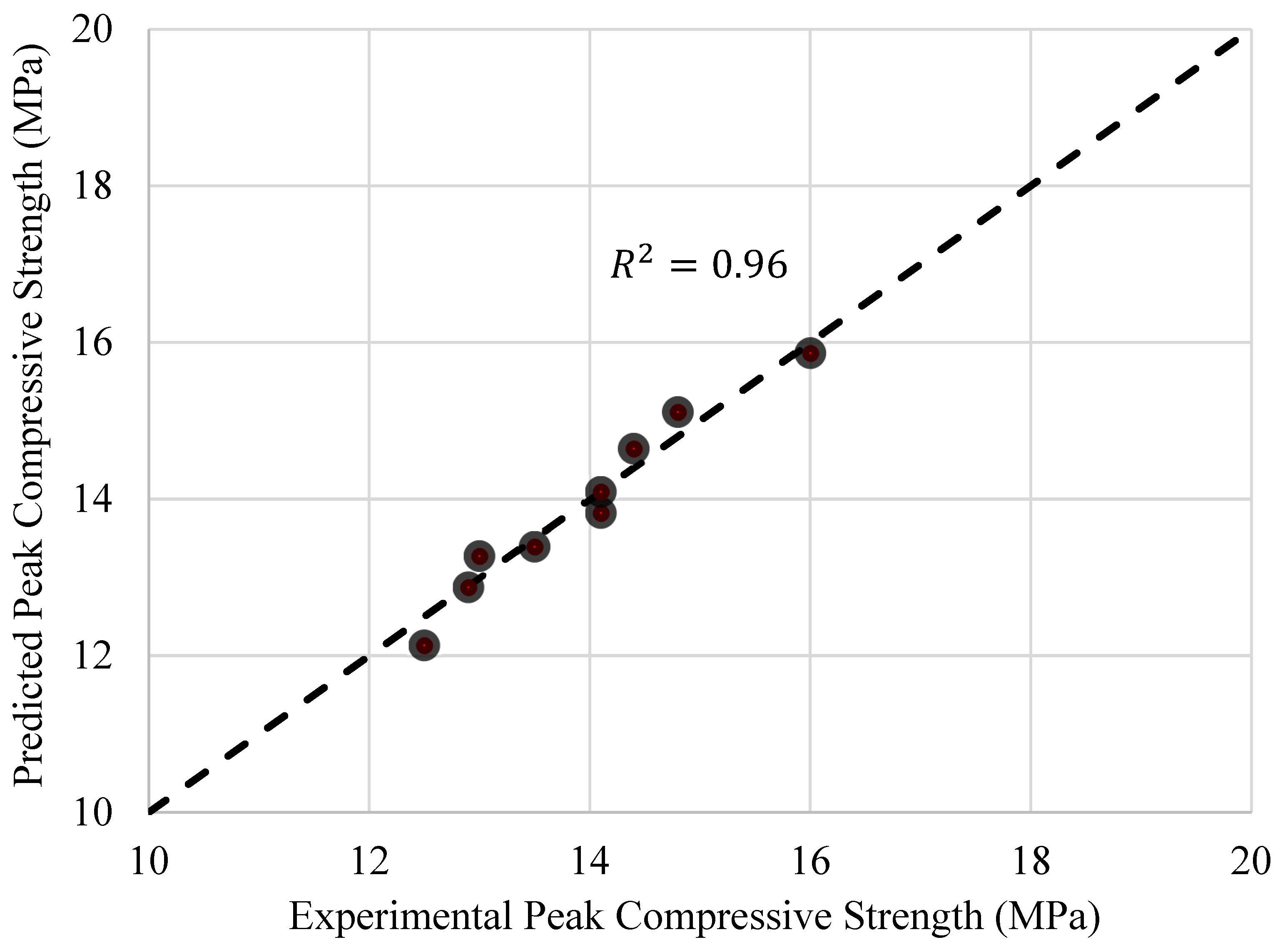

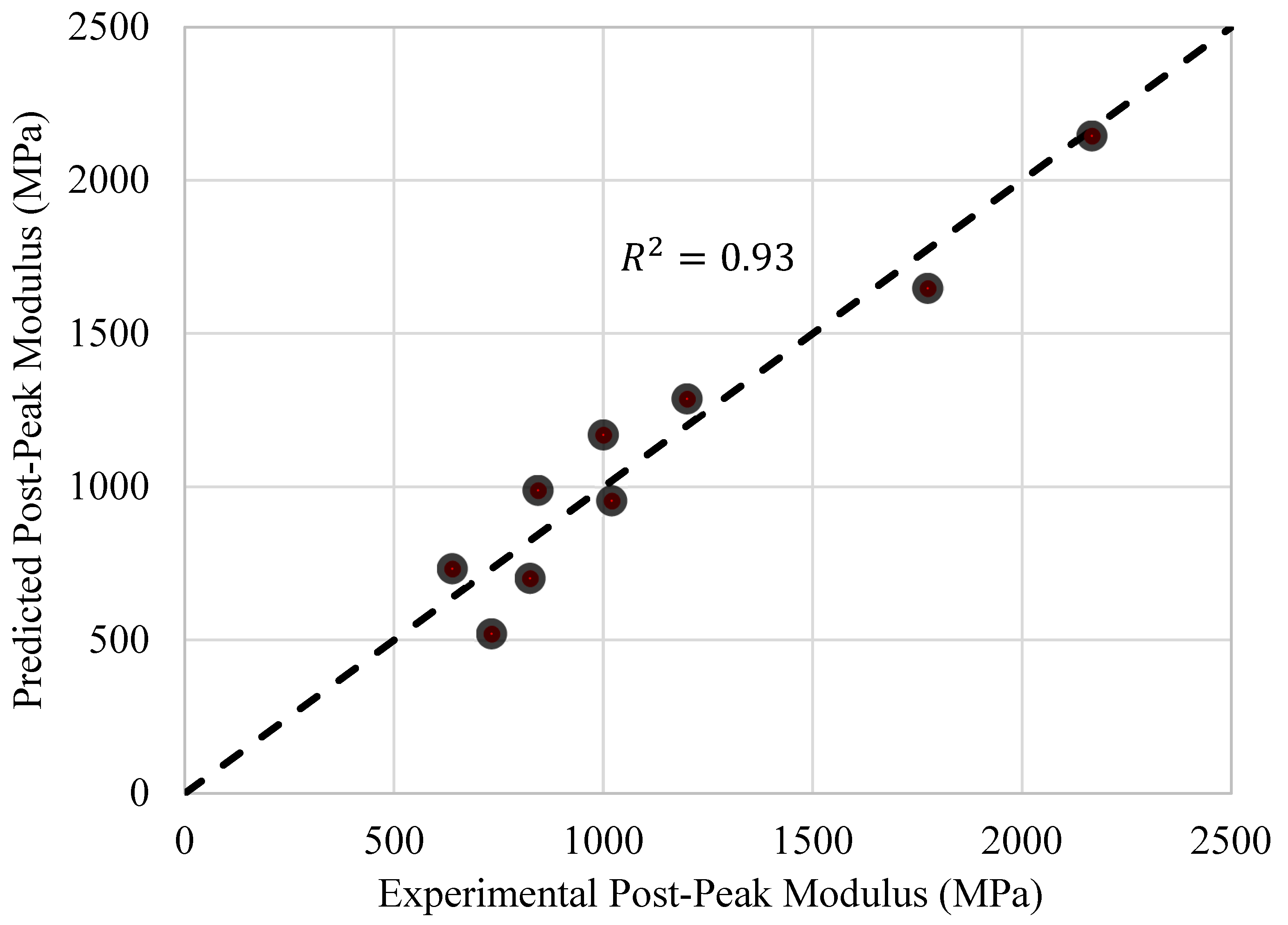
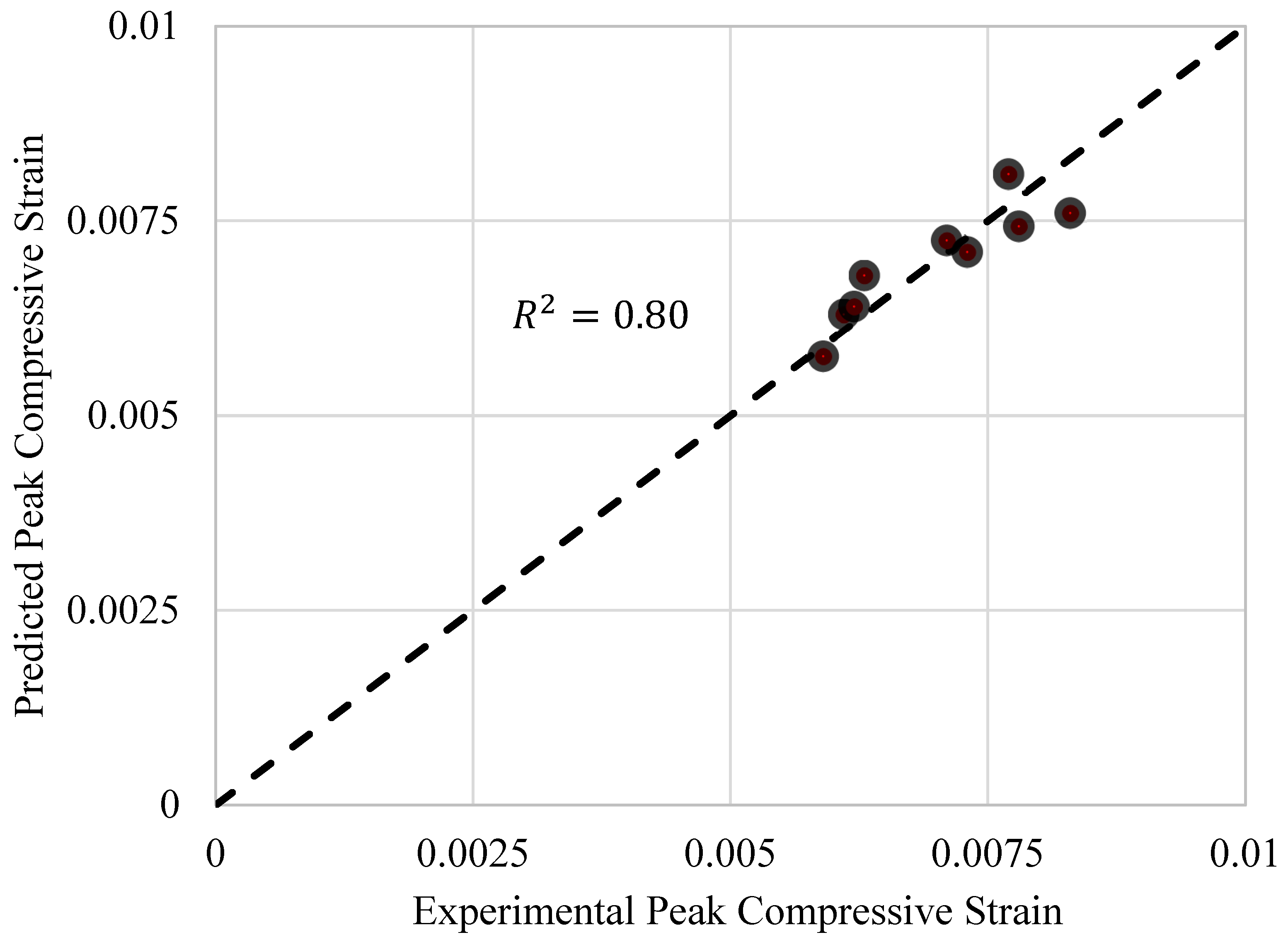

| Group | Number | Name of Specimens | Steel Fiber (%) | Number of Specimens | ||
|---|---|---|---|---|---|---|
| Compressive Loading | Splitting Tensile Loading | Flexural Loading | ||||
| 1 | 1 | CMP-NA-CON | SP-NA-CON | FLX-NA-CON | 0 | 3 |
| 2 | CMP-NA-SF-1 | SP-NA-SF-1 | FLX-NA-SF-1 | 1 | 3 | |
| 3 | CMP-NA-SF-2 | SP-NA-SF-2 | FLX-NA-SF-2 | 2 | 3 | |
| 4 | CMP-NA-SF-3 | SP-NA-SF-3 | FLX-NA-SF-3 | 3 | 3 | |
| 2 | 1 | CMP-CBA-CON | SP-CBA-CON | FLX-CBA-CON | 0 | 3 |
| 2 | CMP-CBA-SF-1 | SP-CBA-SF-1 | FLX-CBA-SF-1 | 1 | 3 | |
| 3 | CMP-CBA-SF-2 | SP-CBA-SF-2 | FLX-CBA-SF-2 | 2 | 3 | |
| 4 | CMP-CBA-SF-3 | SP-CBA-SF-3 | FLX-CBA-SF-3 | 3 | 3 | |
| 3 | 1 | CMP-CBB-CON | SP-CBB-CON | FLX-CBB-CON | 0 | 3 |
| 2 | CMP-CBB-SF-1 | SP-CBB-SF-1 | FLX-CBB-SF-1 | 1 | 3 | |
| 3 | CMP-CBB-SF-2 | SP-CBB-SF-2 | FLX-CBB-SF-2 | 2 | 3 | |
| 4 | CMP-CBB-SF-3 | SP-CBB-SF-3 | FLX-CBB-SF-3 | 3 | 3 | |
| 4 | 1 | CMP-CBC-CON | SP-CBC-CON | FLX-CBC-CON | 0 | 3 |
| 2 | CMP-CBC-SF-1 | SP-CBC-SF-1 | FLX-CBC-SF-1 | 1 | 3 | |
| 3 | CMP-CBC-SF-2 | SP-CBC-SF-2 | FLX-CBC-SF-2 | 2 | 3 | |
| 4 | CMP-CBC-SF-3 | SP-CBC-SF-3 | FLX-CBC-SF-3 | 3 | 3 | |
| Type of Bricks | Density of Bricks (kg/m3) | Compressive Strength of Bricks (MPa) | Water Absorption of Bricks (%) |
|---|---|---|---|
| Type A | 120 | 3.14 | 23.27 |
| Type B | 140 | 8.10 | 16.58 |
| Type C | 145 | 6.26 | 12.30 |
| Mix Ingredients | Quantity (kg/m3) |
|---|---|
| Cement | 242 |
| Fine aggregates | 726 |
| Natural coarse aggregates | 605 |
| Clay brick aggregates | 605 |
| Group | Specimen | Peak Flexural Strength (kN) | Standard Deviation in Peak Flexural Strength | Increase in Peak Flexural Strength (%) | Energy Dissipation (kN-mm) | Increase in Energy Dissipation (%) |
|---|---|---|---|---|---|---|
| 1 | FLX-NA-CON | 6.56 | 0.51 | - | 2.87 | - |
| FLX-NA-SF-1 | 6.70 | 0.14 | 2.13 | 11.50 | 300.70 | |
| FLX-NA-SF-2 | 6.90 | 0.60 | 5.18 | 73.86 | 2473.52 | |
| FLX-NA-SF-3 | 7.18 | 0.29 | 9.45 | 108.59 | 3683.62 | |
| 2 | FLX-CBA-CON | 4.87 | 0.10 | - | 1.44 | - |
| FLX-CBA-SF-1 | 4.90 | 0.18 | 0.62 | 15.89 | 1003.47 | |
| FLX-CBA-SF-2 | 5.03 | 0.33 | 3.29 | 48.91 | 3296.53 | |
| FLX-CBA-SF-3 | 5.13 | 0.21 | 5.34 | 85.30 | 5823.61 | |
| 3 | FLX-CBB-CON | 3.84 | 0.31 | - | 1.02 | - |
| FLX-CBB-SF-1 | 4.62 | 0.25 | 20.31 | 29.89 | 2830.39 | |
| FLX-CBB-SF-2 | 5.40 | 0.26 | 40.62 | 40.11 | 3832.35 | |
| FLX-CBB-SF-3 | 5.77 | 0.19 | 50.26 | 90.43 | 8765.69 | |
| 4 | FLX-CBC-CON | 4.84 | 0.18 | - | 1.22 | - |
| FLX-CBC-SF-1 | 5.40 | 0.50 | 11.57 | 35.47 | 2807.38 | |
| FLX-CBC-SF-2 | 5.60 | 0.37 | 15.70 | 41.27 | 3282.79 | |
| FLX-CBC-SF-3 | 5.73 | 0.20 | 18.39 | 83.55 | 6748.36 |
| Group | Specimen | Peak Splitting Tensile Strength (kN) | Standard Deviation in Peak Splitting Tensile Strength | Increase in Peak Splitting Tensile Strength (%) | Energy Dissipation (kN-mm) | Increase in Energy Dissipation (%) |
|---|---|---|---|---|---|---|
| 1 | SP-NA-CON | 121 | 3.50 | - | 21.42 | - |
| SP-NA-SF-1 | 143 | 6.79 | 18.18 | 161.40 | 653.50 | |
| SP-NA-SF-2 | 157 | 5.55 | 29.75 | 279.83 | 1206.39 | |
| SP-NA-SF-3 | 164 | 4.42 | 35.53 | 342.31 | 1498.08 | |
| 2 | SP-CBA-CON | 91 | 5.89 | - | 73.50 | - |
| SP-CBA-SF-1 | 108 | 7.98 | 18.68 | 104.11 | 41.64 | |
| SP-CBA-SF-2 | 119 | 3.30 | 30.76 | 285.71 | 288.72 | |
| SP-CBA-SF-3 | 124 | 6.10 | 36.26 | 251.77 | 242.54 | |
| 3 | SP-CBB-CON | 98 | 3.98 | - | 45.33 | - |
| SP-CBB-SF-1 | 121 | 6.83 | 23.46 | 159.38 | 251.59 | |
| SP-CBB-SF-2 | 128 | 5.79 | 30.61 | 242.22 | 434.34 | |
| SP-CBB-SF-3 | 143 | 5.00 | 45.91 | 261.94 | 477.85 | |
| 4 | SP-CBC-CON | 102 | 5.10 | - | 127.51 | - |
| SP-CBC-SF-1 | 125 | 2.30 | 22.54 | 219.01 | 71.75 | |
| SP-CBC-SF-2 | 155 | 7.92 | 51.96 | 372.21 | 191.91 | |
| SP-CBC-SF-3 | 170 | 5.79 | 66.67 | 377.13 | 195.76 |
| Group | Specimen | Peak Compressive Strength (MPa) | Standard Deviation in Peak Compressive Strength | Increase in Peak Compressive Strength (%) | Peak Compressive Strain | Elastic Modulus (GPa) | Increase in Elastic Modulus (%) |
|---|---|---|---|---|---|---|---|
| 1 | CMP-NA-CON | 15.5 | 1.11 | - | 0.0063 | 2.58 | - |
| CMP-NA-SF-1 | 16.8 | 2.21 | 8.39 | 0.0062 | 2.88 | 11.63 | |
| CMP-NA-SF-2 | 17.9 | 2.09 | 15.48 | 0.0057 | 3.93 | 52.33 | |
| CMP-NA-SF-3 | 19.3 | 1.75 | 24.52 | 0.0056 | 3.94 | 52.71 | |
| 2 | CMP-CBA-CON | 11.7 | 1.11 | - | 0.0081 | 1.42 | - |
| CMP-CBA-SF-1 | 12.5 | 0.67 | 6.84 | 0.0077 | 1.73 | 21.83 | |
| CMP-CBA-SF-2 | 12.9 | 2.10 | 10.26 | 0.0078 | 2.12 | 49.29 | |
| CMP-CBA-SF-3 | 14.1 | 1.19 | 20.51 | 0.0071 | 2.63 | 85.21 | |
| 3 | CMP-CBB-CON | 09.9 | 2.25 | - | 0.0051 | 2.08 | - |
| CMP-CBB-SF-1 | 13.5 | 1.67 | 36.36 | 0.0063 | 2.38 | 14.42 | |
| CMP-CBB-SF-2 | 14.4 | 2.21 | 45.45 | 0.0061 | 2.70 | 29.81 | |
| CMP-CBB-SF-3 | 16.0 | 1.21 | 61.62 | 0.0059 | 3.30 | 58.65 | |
| 4 | CMP-CBC-CON | 12.8 | 2.10 | - | 0.0096 | 1.62 | - |
| CMP-CBC-SF-1 | 13.0 | 0.53 | 1.56 | 0.0083 | 1.62 | 0.00 | |
| CMP-CBC-SF-2 | 14.1 | 1.07 | 10.16 | 0.0073 | 1.90 | 17.28 | |
| CMP-CBC-SF-3 | 14.8 | 2.10 | 15.62 | 0.0062 | 2.55 | 57.41 |
Disclaimer/Publisher’s Note: The statements, opinions and data contained in all publications are solely those of the individual author(s) and contributor(s) and not of MDPI and/or the editor(s). MDPI and/or the editor(s) disclaim responsibility for any injury to people or property resulting from any ideas, methods, instructions or products referred to in the content. |
© 2023 by the authors. Licensee MDPI, Basel, Switzerland. This article is an open access article distributed under the terms and conditions of the Creative Commons Attribution (CC BY) license (https://creativecommons.org/licenses/by/4.0/).
Share and Cite
Yooprasertchai, E.; Bahrami, A.; Saingam, P.; Hussain, Q.; Ejaz, A.; Joyklad, P. Incorporation of Steel Fibers to Enhance Performance of Sustainable Concrete Made with Waste Brick Aggregates: Experimental and Regression-Based Approaches. Buildings 2023, 13, 2820. https://doi.org/10.3390/buildings13112820
Yooprasertchai E, Bahrami A, Saingam P, Hussain Q, Ejaz A, Joyklad P. Incorporation of Steel Fibers to Enhance Performance of Sustainable Concrete Made with Waste Brick Aggregates: Experimental and Regression-Based Approaches. Buildings. 2023; 13(11):2820. https://doi.org/10.3390/buildings13112820
Chicago/Turabian StyleYooprasertchai, Ekkachai, Alireza Bahrami, Panumas Saingam, Qudeer Hussain, Ali Ejaz, and Panuwat Joyklad. 2023. "Incorporation of Steel Fibers to Enhance Performance of Sustainable Concrete Made with Waste Brick Aggregates: Experimental and Regression-Based Approaches" Buildings 13, no. 11: 2820. https://doi.org/10.3390/buildings13112820
APA StyleYooprasertchai, E., Bahrami, A., Saingam, P., Hussain, Q., Ejaz, A., & Joyklad, P. (2023). Incorporation of Steel Fibers to Enhance Performance of Sustainable Concrete Made with Waste Brick Aggregates: Experimental and Regression-Based Approaches. Buildings, 13(11), 2820. https://doi.org/10.3390/buildings13112820







